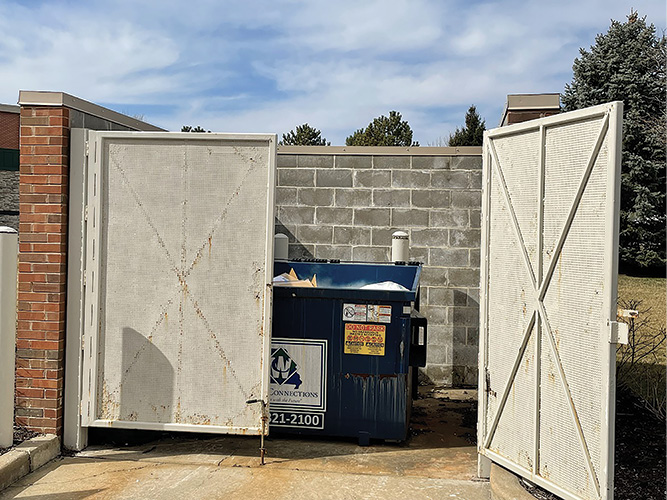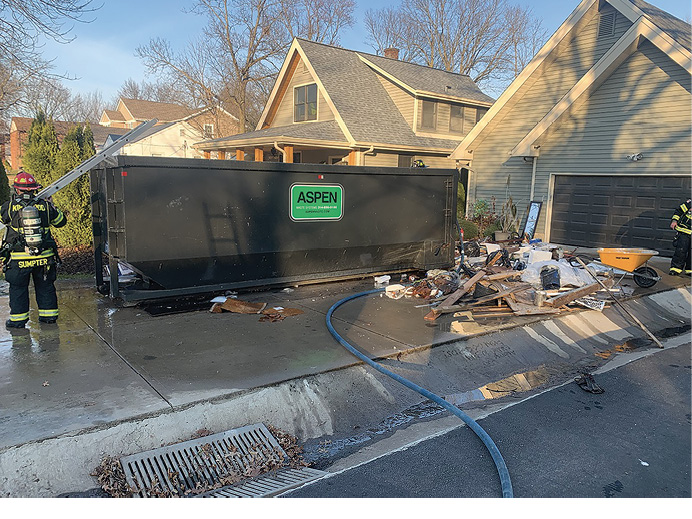TRAINING NOTEBOOK ❘ By BRIAN ZAITZ
Many fire departments across the country consider dumpster fires a “routine” response. However, these fires can present unique challenges and hazards that firefighters do not often consider. Traditionally a one-unit response, dumpster fires are often viewed as simple, contained “trash” fires that are mitigated with either a hoseline or deck gun and water to overcome the burning materials. Often, we give little to no thought to what is burning, possible hazardous material runoff, and toxic smoke. Given the nature of dumpsters being in public settings and “catchalls” for almost any material, it is necessary to take a closer look at these not-so-routine emergencies.
Types of Dumpsters
Dumpsters come in various sizes and shapes and are used to contain various materials such as normal residential and business waste, recycled materials, food waste, and hazardous materials. Although their shape and style can assist in determining the contents, it is not a guarantee of what’s inside.
RELATED FIREFIGHTER TRAINING
- Firefighter Training: Responding to Dumpster and Trash Fires
- Drill of the Week: Dumpster Fires
- Dumpster and Trash Fires
- DON’T UNDERESTIMATE THE DUMPSTER
Multifamily residential dumpster. The most common dumpster is the five- to seven-yard residential dumpster (photo 1). Traditionally on wheels, we can find them at multifamily residential occupancies, strip malls, small businesses, and restaurants behind the structure, often in a three-sided, nonroofed structure or fenced area for aesthetics. It is important to chock the wheels so the dumpster does not move during fire attack, especially when it fills up with water. Typically, there are two plastic lids for controlling odors, keeping out animals, and appearance. The dumpsters are easily accessible but are sometimes placed in such a manner that waste companies need to roll them out manually prior to lifting into the refuse truck. This can present an access issue for fire attack.

(1) Photos by author.
One good aspect of these dumpsters is that they are usually away from the structure, which assists in exposure risk to adjacent buildings and other occupancies. Although these dumpsters are used for normal refuse, it is not uncommon to see them used for other kinds including old appliances, yard waste, old fuel containers, and so on. With these dumpsters normally being unmonitored, they often become dropping points for anything that people want to get out of their homes or for businesses that cannot dispose of trash in normal household garbage cans.
Construction dumpsters. These dumpsters vary in size from 10 to 40 yards (photo 2). They usually have a large opening/door on one side to make access and dumping easier, are constructed of solid steel, and are normally delivered by a rollback vehicle and placed near the business to reduce steps for job site waste removal. These dumpsters can be on the site of construction projects, home/business remodels, and even homes where homeowners are looking to declutter.

(2)
Although there are often restrictions placed on what can be discarded into the dumpster, it is hardly regulated. Fires in these dumpsters are often close to structures and can pose a large fire load, depending on how close the project is to being completed. It is also noteworthy that these dumpsters can have access issues, depending on site location and the height of the dumpster.
Recycling bins. Large recycling bins are a popular in many communities, often holding a single product such as paper, cardboard, or plastic (photos 3, 4). Although these containers should not have an ignition source, they often fall victim to arson, as they are on public property such as a city parking or school lot, away from the building and often out of the sight of cameras.

(3)

(4)
Again, these can carry a large, compacted fuel loads because the materials are often stacked and packed into the container. Access to these containers can be difficult; the drop points are often small to reduce nonrecyclable refuse from entering the container. Note that these can also be industrial recycling containers specific to manufacturing and could contain large quantities of flammable metals, chemicals, or other products noted on a preplan. They may also have on-site extinguishing agents and suppression systems for fire.
Special use. These dumpsters or containers, which are similar to recycling bins, are used for a single product. They are often placed near restaurants for discarding expelled cooking oil or near similar type buildings and are much smaller than regular bins (photo 5). Because of the nature of the product discarded, it is necessary to identify the product given the dumpster design or label on the outside, if visible.

(5)
Although not technically a dumpster, it is often categorized as one as it relates to fire tactics as being a drop-off bin for charity (photo 6). These bins or containers vary in size and design, from metal containers to those similar to that of a residential shed. Although they are meant to collect clean clothing, they can become drop sites for anything such as bedding, chairs, and other household items. In addition, it is not uncommon to find large amounts of collections outside the container as well, adding to the fuel load.

(6)
Tactics
Approaching dumpster fires as simple Class A refuse fires can set us up for failure. As stated, these containers can carry a variety of materials, including hazmats. Always approach them wearing full personal protective equipment and self-contained breathing apparatus.
Accessing them can sometimes be difficult; using an elevated waterway or deck gun can provide the needed fire flow as well as provide safety for firefighters. This provides a good initial attack for a well-involved dumpster.
Use a handline and tool to overhaul and fully extinguish a dumpster fire. Understanding exposures is key. Given the proximity of the dumpster to the building and the progress of the fire, you may need additional units to not only check for extension but also assist in venting the structure (photo 7).

(7)
Commercial dumpster fires are best approached by accessing the hatch located on one of its shorter sides. You can attack rolling dumpster fires usually only from the top and recycle container fires with a saw or by removing the small side-access hatch. Regardless, it is imperative to properly overhaul to ensure that the fire is completely out. Once the fire is knocked down, understand the materials, and examine the refuse. Be aware of containers, cylinders, and other products that could fail, causing injury, and possible leaking or burning hazmats.
Water supply is often an afterthought on these alarms. Typically, after the apparatus has run out of water, crews rapidly try to secure a water supply or call for additional units. Try to find a water supply on the way into the scene. Laying a supply line can provide the necessary water supply to knock down and fully extinguish even a residential dumpster fire.
Although most departments respond with a single unit, do not hesitate to request additional resources such as an additional engine or truck to assist with overhaul and support the operations. Having the mindset of how to approach a small hazmat vs. trash fire will harbor a safer scene and encourage crews to request additional resources to support the operation.
Dumpster fires are often thought of as routine emergencies. However, approaching them as such can lead to devastating consequences. Reviewing the types of refuse containers and their contents, understanding how to access them for fire attack, and having situational awareness of the projects within your first-due area will greatly enhance your ability to operate safely and effectively at these scenes.
BRIAN ZAITZ is the assistant chief of operations and training for the Kirkwood (MO) Fire Department with 21 years of service. He has an associate of applied science in paramedic technology, a bachelor of science in fire science management, and a master of science in human resource development. Zaitz is also a graduate of the National Fire Academy’s Executive Fire Officer Program.

